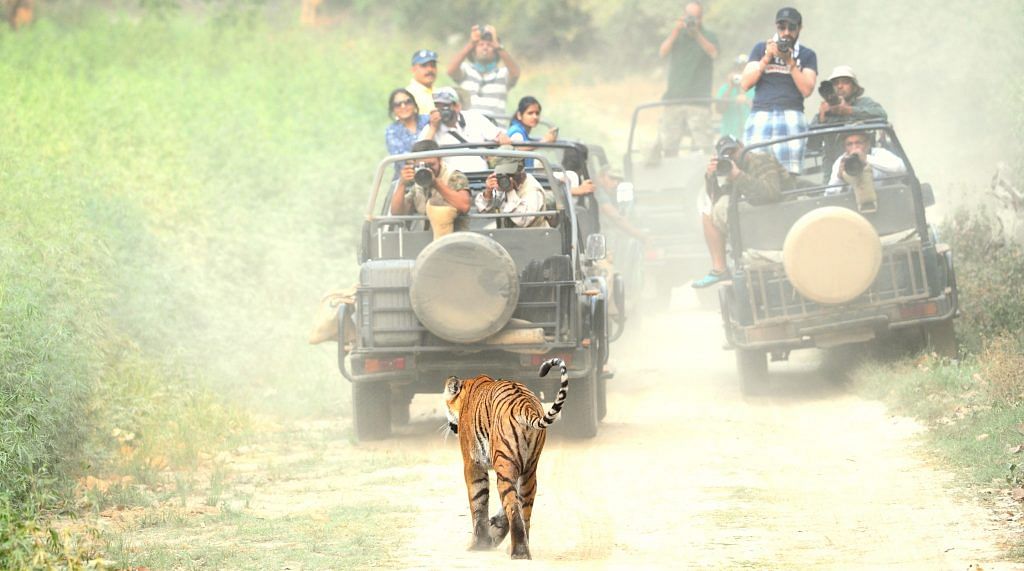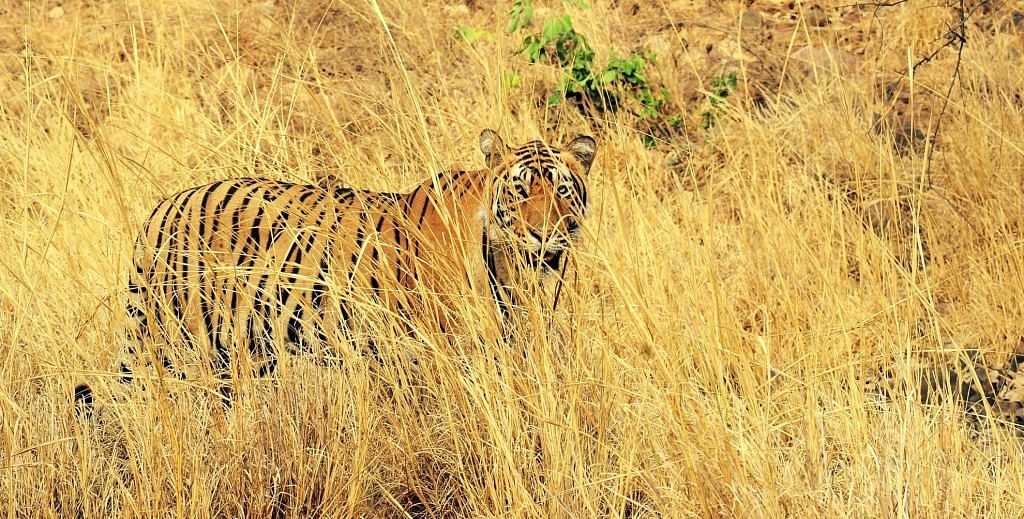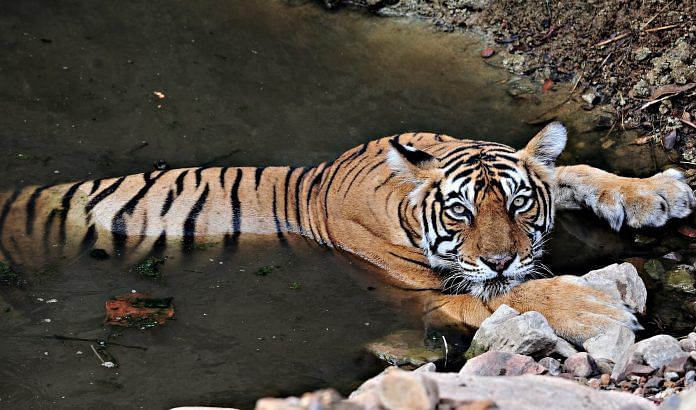Just how many tigers will be enough for India? Fraught with several risks, the question itself is bound to raise the hackles of the country’s powerful ‘tiger lobby’. But asked it must be, even if it necessitates stepping on the toes of powerful individuals, NGOs and organisations whose professional existence all these years rest upon pulling the tiger out of the death-hole where, at one time, it was found dangling by the tip of its tail.
This was roughly half a century ago, when then Prime Minister Indira Gandhi launched Project Tiger in 1973. Since then, the tiger has emerged as a sprightly survivor. A cursory glance at the past few years’ reports and official data would show that the tiger has leapt way ahead of its killers, making a remarkable comeback in dozens of protected areas in all corners of India.
As recently as two months ago, when Prime Minister Narendra Modi visited Kedarnath shrine, guess who followed him to the high-altitude Himalayan landscape? The tiger, of course! The discovery of the big cat at a height of 3,400 metres is extremely rare, and going by the forest department of Uttarakhand, which is still gushing over the camera-trap images of a male tiger found sauntering in the Kedarnath Wildlife Sanctuary, it could be a harbinger of things to come.
This brings us to the widely-acknowledged, but less understood, syndrome of ‘what to do with the revolutionaries after the revolution is over?’ At a campfire under Ramnagar’s starry night few winters ago, a shouting distance from the boundary of Corbett National Park, I heard the resort owner remark casually: “Like it or not, India today has more tiger experts than tigers.”

The tiger wave
It was in 2006 that the tiger population in India slipped to an all-time low of 1,411 and things started heating up on many fronts. The situation was no doubt bad for the tigers, but good enough for a fledging telecom company to build its business foundation through a hugely publicised ‘Save Our Tigers’ campaign. Ironically, the company sank without a trace while the tiger continues to march ahead with increased vigour and aplomb.
Also read: The woman forest guard who stared a tiger down for 90 minutes, and lived to tell the tale
This, however, did not stop a large number of hotel owners, tour operators, cash-strapped NGOs, coffee table book writers-turned-tiger experts and others from joining the “save tiger” rush. Barring a few well-meaning tiger supporters and agencies, most others were spurred by the scent of easy money, which came in the name of supporting India’s flagship species.
This motley group still remains active, even though it’s clear that the goalpost on the tigerscape has changed dramatically in recent years. Otherwise, why would Rajesh Gopal — former head of Project Tiger and currently the chief of Global Tiger Fund, the inter-governmental international body set up for conservation of big cats in the wild — come out with a seemingly preposterous statement earlier this year that India’s tiger carrying capacity is packed and the forests cannot hold any more tigers.
From ecology to economy
On any other day and for any other endangered species, this amazing back-from-the-brink tale would have brought about all round cheers. For the tiger conservation groups, the revelation brought a deafening silence, which may not be hard to comprehend. With the patient having recovered completely, how will the doctors continue the treatment? Anybody with lesser credentials than Rajesh Gopal would have been booed out of the room. But not him. By setting up the cat among the pigeons, the former IFS officer’s statement hit two targets: (1) it succeeded in creating a level-playing field for rational, scientific voices to be heard aloud, and (2) it made the powerful “tiger lobby” fidgety.
Truth be told, it’s not the tiger’s future that is at stake now.
Make no mistake. Tiger tourism is a big ticket game in India. And it has just started to warm up. A full-day safari ride in Rajasthan’s Ranthambore costs Rs 50,000. Before the Supreme Court’s recent directive banning the use of forest department elephants for tourism in the tiger reserves, it would have cost you a whopping Rs 60,000 for a seven-hour elephant ride in Madhya Pradesh’s Bandhavgarh Tiger Reserve.
Even a normal, three-hour jungle safari in most national parks costs anywhere between Rs 4,000 to Rs 7,000 through ‘government authorised’ vehicles. Following the series of court orders and subsequent changes in the guidelines by most state governments, no private vehicle can now enter a tiger reserve.
Also read: Killing Avni: Trigger-happy solution or failure of India’s tiger conservation policy?
A number of erstwhile tiger support groups have now hopped onto the tourism bandwagon. They all know which side of the bread has the butter. Nothing wrong with it, but at least don’t stick to the cause of tiger conservation in the garb of securing high-end clients.
Riding high on the new tiger wave now sweeping the tourism sector of India are thousands of private resorts and tour operators, who in turn have created a large number of employment opportunities in dozens of towns situated next to the tiger reserves. All of this is fine. Social media too has played a big hand. Facebook alone has dozens of groups where hundreds of new photographs clicked by tiger enthusiasts from all over India change on an hourly basis.
All of a sudden, the tiger has been dragged out of the forest and brought into our drawing rooms. Any trip to a national park, which does not result in at least one “head on” photograph of an approaching tiger, is considered a waste of time and money. And reason enough for a repeat visit.

Tigers need their forest, not lobby
Coming back to the original query, does India have sufficient number of tigers in its forests? Out of a total of some 4,000 tigers out there in the wild globally, India supposedly holds about 3,000. This is much better than the downright scary figure of 1,411 hardly 13 years ago, but it’s just a fraction of 40,000-plus tigers estimated to have been roaming the wilds of India at the turn of the last century.
But 119 years ago, much of India was covered by forests. Being a territorial animal, a tiger doesn’t move out or welcome another tiger in its territory. So, a typical forest patch 100 years ago would have held the same number of tigers as it would now. With the forest cover in the country having shrunk considerably, the tigers too have made required adjustments. Of course, with no fresh battle to fight, this will not go down well with the ‘tiger lobby’.
Also read: Rhino, snow leopard, red panda — the endangered species Modi govt wants to protect
Unlike many other big cats, such as the opportunistic leopard, which has no qualms in entering a village in search of a meal, the king of the Indian jungles seldom moves out of its turf. But it definitely requires a healthy forest with sufficient prey base to uphold its territory. This is why, during the last few tiger censuses in different parts of the country, the Wildlife Institute of India (WII) and other scientific minds stressed upon the importance of securing the Critical Tiger Habitat (CTH) before anything else.
Maintaining Critical Tiger Habitats, as also tiger-corridors connecting various forests where it can move freely and avoid inbreeding, would place a tiger as a part of the holistic system, and not above it. In its essence, the approach entails supporting “all life” and not just the tiger. If only this approach was understood earlier, our cities would not have lost sparrows, frogs and butterflies.
Strange as it may seem, these things can often be understood better by poetry. This perhaps could be the reason why, while touching on a tiger’s importance in his famous summation, John Seidensticker, the renowned scientist at Smithsonian’s National Zoological Park in Washington, took the metaphysical path to drive home the point:
“The tiger lives in a world of sunlight and shadow
Always secretive, never devious
Always a killer, never a murderer
Solitary, never alone
For it’s an irreplaceable link
In the process and wholeness of life.”
The author is a senior-journalist and filmmaker who writes on environment and wildlife. Views are personal.




Thank you very much for presenting this data about 4 best garden wedding venues in Bangalore, it’s known how to get approved but what are the next steps after getting the approval… Wonderful information, thanks a lot for sharing kind of content with us… great post!
It’s not only about Tigers, but it’s also about the planet. Tigers play the main role in the food chain that’s why their conservation is very much necessary.
Of India’s 50 tiger reserves, that makes up only 1/10th of its net forest cover, about half are nearly empty. A dozen have no tigers or less than 10.
The other half comprising of the well-managed tiger reserves are at their carrying capacity, with even their fragmented fringes packed with tigers leading to conflict with people, due to inadequate corridor connectivity with adjoining forests.
Surplus tigers spilling out to reclaim old lands are ending up in far inferior habitats, degraded & overexploited over the years due to their absence. Many of the tigers that recently managed to reach new places have died
Having a few thousand tigers ghettoed in so called “critical tiger habitats” that makes up less than 3% of India’s landmass don’t mean much… It’s time India concentrated on habitat restoration around the reserves.